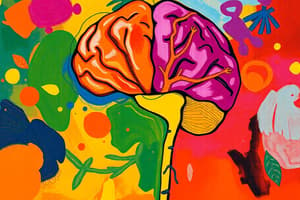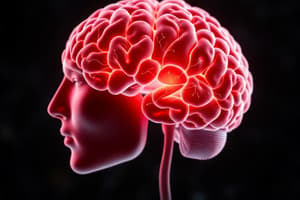Podcast
Questions and Answers
What is the endocrine system?
What is the endocrine system?
A complex network of glands and organs that secrete hormones into the bloodstream to regulate various bodily functions, including metabolism, growth, development, mood, sexual function, and homeostasis.
Which of the following is NOT a function of the hypothalamus?
Which of the following is NOT a function of the hypothalamus?
- Digestion and absorption of nutrients (correct)
- Autonomic nervous system regulation
- Thirst and water intake
- Endocrine regulation
The hypothalamus produces both releasing and inhibiting hormones that control the pituitary gland.
The hypothalamus produces both releasing and inhibiting hormones that control the pituitary gland.
True (A)
What is the function of the pituitary gland?
What is the function of the pituitary gland?
Which of the following hormones is NOT produced by the anterior pituitary?
Which of the following hormones is NOT produced by the anterior pituitary?
What is the function of the thyroid gland?
What is the function of the thyroid gland?
Which of the following is NOT a function of the thyroid hormones?
Which of the following is NOT a function of the thyroid hormones?
The thymus gland is largest in adulthood.
The thymus gland is largest in adulthood.
What is the function of the adrenal glands?
What is the function of the adrenal glands?
Which of the following hormones is produced in the adrenal medulla?
Which of the following hormones is produced in the adrenal medulla?
What is the function of the pancreas?
What is the function of the pancreas?
Which type of cell in the pancreas produces insulin?
Which type of cell in the pancreas produces insulin?
What is the function of the gonads?
What is the function of the gonads?
Which of the following hormones is produced by the testes?
Which of the following hormones is produced by the testes?
What is the importance of the hormonal feedback mechanism?
What is the importance of the hormonal feedback mechanism?
Which of the following is an example of positive feedback in the endocrine system?
Which of the following is an example of positive feedback in the endocrine system?
Negative feedback is the most common type of feedback loop in the endocrine system.
Negative feedback is the most common type of feedback loop in the endocrine system.
What are the three main functions of the endocrine feedback mechanism?
What are the three main functions of the endocrine feedback mechanism?
What are the disorders of the hypothalamus?
What are the disorders of the hypothalamus?
What are the disorders of the anterior pituitary?
What are the disorders of the anterior pituitary?
What are the disorders of the pineal gland?
What are the disorders of the pineal gland?
What are the disorders of the thyroid gland?
What are the disorders of the thyroid gland?
What are the disorders of the pancreas?
What are the disorders of the pancreas?
What are the disorders of the gonads?
What are the disorders of the gonads?
Flashcards
Endocrine System
Endocrine System
A complex network of glands and organs that secrete hormones into the bloodstream to regulate various bodily functions.
Hormones
Hormones
Chemical messengers produced by glands that regulate specific functions in the body.
Target Organs/Cells
Target Organs/Cells
Organs or cells that are affected by specific hormones.
Feedback Mechanisms
Feedback Mechanisms
Signup and view all the flashcards
Hypothalamus
Hypothalamus
Signup and view all the flashcards
Releasing Hormones
Releasing Hormones
Signup and view all the flashcards
Inhibiting Hormones
Inhibiting Hormones
Signup and view all the flashcards
Oxytocin
Oxytocin
Signup and view all the flashcards
Antidiuretic Hormone (ADH)
Antidiuretic Hormone (ADH)
Signup and view all the flashcards
Prader-Willi Syndrome
Prader-Willi Syndrome
Signup and view all the flashcards
Syndrome of Inappropriate ADH Secretion (SIADH)
Syndrome of Inappropriate ADH Secretion (SIADH)
Signup and view all the flashcards
Diabetes Insipidus
Diabetes Insipidus
Signup and view all the flashcards
Pituitary Gland
Pituitary Gland
Signup and view all the flashcards
Anterior and Posterior Pituitary
Anterior and Posterior Pituitary
Signup and view all the flashcards
Growth Hormone (GH)
Growth Hormone (GH)
Signup and view all the flashcards
Prolactin (PRL)
Prolactin (PRL)
Signup and view all the flashcards
Adrenocorticotropic Hormone (ACTH)
Adrenocorticotropic Hormone (ACTH)
Signup and view all the flashcards
Thyroid-Stimulating Hormone (TSH)
Thyroid-Stimulating Hormone (TSH)
Signup and view all the flashcards
Luteinizing Hormone (LH)
Luteinizing Hormone (LH)
Signup and view all the flashcards
Follicle-Stimulating Hormone (FSH)
Follicle-Stimulating Hormone (FSH)
Signup and view all the flashcards
Pineal Gland
Pineal Gland
Signup and view all the flashcards
Melatonin
Melatonin
Signup and view all the flashcards
Thyroid Gland
Thyroid Gland
Signup and view all the flashcards
Thyroxine (T4)
Thyroxine (T4)
Signup and view all the flashcards
Triiodothyronine (T3)
Triiodothyronine (T3)
Signup and view all the flashcards
Calcitonin
Calcitonin
Signup and view all the flashcards
Parathyroid Glands
Parathyroid Glands
Signup and view all the flashcards
Parathyroid Hormone (PTH)
Parathyroid Hormone (PTH)
Signup and view all the flashcards
Thymus Gland
Thymus Gland
Signup and view all the flashcards
Thymosin
Thymosin
Signup and view all the flashcards
Adrenal Glands
Adrenal Glands
Signup and view all the flashcards
Cortisol
Cortisol
Signup and view all the flashcards
Adrenaline (Epinephrine)
Adrenaline (Epinephrine)
Signup and view all the flashcards
Pancreas
Pancreas
Signup and view all the flashcards
Insulin
Insulin
Signup and view all the flashcards
Glucagon
Glucagon
Signup and view all the flashcards
Gonads
Gonads
Signup and view all the flashcards
Testosterone
Testosterone
Signup and view all the flashcards
Estrogen
Estrogen
Signup and view all the flashcards
Progesterone
Progesterone
Signup and view all the flashcards
Study Notes
Endocrine System Overview
- The endocrine system is a complex network of glands and organs that secrete hormones into the bloodstream.
- Hormones regulate various bodily functions, including metabolism, growth, development, mood, sexual function, and homeostasis.
- The endocrine system communicates with itself and other body systems using hormones.
Hypothalamus
- Location: A small region of the brain located just below the thalamus, part of the diencephalon.
- Function: Responsible for maintaining the body's internal balance (homeostasis) and regulating the endocrine system.
- Function: Regulates a wide range of processes including endocrine regulation, thirst and water intake, hunger and food intake, autonomic nervous system regulation, biological circadian rhythm, body temperature, blood pressure, breast feeding, learning and memory, sexual drive, and emotional expression.
- Hormones regulating the anterior pituitary (e.g., TRH, GnRH, CRH, GnRH, GHRH).
- Hormones regulating the anterior pituitary (e.g., somatostatin, dopamine).
- Hormones released to the posterior pituitary (e.g., oxytocin, ADH/Vasopressin).
- Disorders: Kallman syndrome and Prader Willi syndrome
- SIADH VS DIABETES INSIPIDUS
Pituitary Gland
- Location: Located at the base of the brain, below the hypothalamus.
- Function: Often referred to as the "master gland" because it controls other endocrine glands.
- The pituitary secretes hormones that regulate growth, metabolism, and reproduction.
- Parts: Anterior pituitary (adenohypophysis) and Posterior pituitary (neurohypophysis)
- Anterior Pituitary Hormones: Growth Hormone (GH), Prolactin (PRL), Adrenocorticotropic Hormone (ACTH), Thyroid-Stimulating Hormone (TSH), Luteinizing Hormone (LH),Follicle-Stimulating Hormone (FSH).
- Posterior Pituitary Hormones: Oxytocin, and Antidiuretic Hormone (ADH)/Vasopressin.
- Disorders: Hypopituitarism and other disorders
Pineal Gland
- A small, pea-shaped endocrine gland located in the brain.
- It plays a vital role in regulating biological rhythms, particularly the sleep-wake cycle.
- It secretes the hormone melatonin.
- Functions: Melatonin secretion, regulation of circadian rhythm, role in puberty.
- Disorders: Sleep disorders, Pineal tumors, calcification.
Thyroid Gland
- A butterfly-shaped endocrine gland located in the neck, just below the larynx (voice box).
- Function: Regulates metabolism, growth, and development, temperature regulation and calcium homeostasis.
- Cell types: Follicular cells, parafollicular cells (C cells).
- Thyroid Hormones: Thyroxine (T4), Triiodothyronine (T3), Calcitonin.
- Disorders: Hypothyroidism, Hyperthyroidism, Goiter, Thyroid nodules or Cancer.
Parathyroid Glands
- Small, pea-shaped endocrine glands located on the posterior surface of the thyroid gland.
- Function: Regulates calcium and phosphate balance in the blood.
- Calcium Regulation, Phosphorus Regulation.
- Disorders: Hyperparathyroidism, Hypoparathyroidism, Pseudohypoparathyroidism.
Thymus Gland
- Location: Located in the upper chest, just behind the sternum.
- It is largest in childhood and begins to shrink after puberty.
- Functions: T-cell maturation and education, immune system development, secretion of immune-modulating hormone.
- Disorders: Thymic Atrophy, DiGeorge syndrome, Thymoma and Autoimmune diseases
Adrenal Glands
- Two small, triangular endocrine glands located on top of each kidney.
- Function: Play a critical role in responding to stress and maintaining homeostasis by producing various hormones involved in metabolism, immune response, blood pressure regulation, and other functions.
- Structure: Adrenal cortex (outer layer) and adrenal medulla (inner layer).
- Adrenal Cortex Hormones: Mineralocorticoids, glucocorticoids, and androgens.
- Adrenal Medulla Hormones: Catecholamines (e.g., adrenaline/epinephrine and noradrenaline/norepinephrine).
- Regulation: The HPA axis (hypothalamic-pituitary-adrenal axis) regulates cortisol secretion. RAAS (renin-angiotensin-aldosterone system) regulates aldosterone secretion.
- Disorders: Overactivity (e.g., Cushing's Syndrome, Hyperaldosteronism, Pheochromocytoma) and Underactivity (e.g., Addison's Disease, Adrenal Crisis).
Pancreas
- A vital glandular organ located in the abdomen, behind the stomach.
- Function: Has both endocrine and exocrine functions, making it crucial for digestion and glucose metabolism.
- Contains islets of Langerhans (endocrine) and acinar cells (exocrine).
- Endocrine pancreas: Secretes hormones into the bloodstream (e.g., insulin, glucagon, somatostatin, pancreatic polypeptide, ghrelin).
- Exocrine pancreas: Secretes digestive enzymes into the duodenum (e.g., amylase, lipase, protease).
Gonads
- Testes in males and ovaries in females serve dual roles as endocrine glands and reproductive organs.
- Produce sex hormones that regulate sexual development, reproductive function, and secondary sexual characteristics.
- Hormones secreted by the testes include testosterone and inhibin.
- Hormones secreted by the ovaries include estrogen, progesterone, inhibin, and relaxin.
- Regulation: The HPG axis (hypothalamic-pituitary-gonadal axis) controls gonadal hormone secretion.
Studying That Suits You
Use AI to generate personalized quizzes and flashcards to suit your learning preferences.




